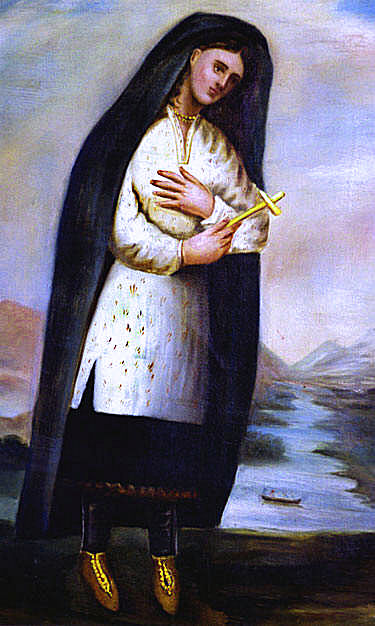
St. Kateri Tekakwitha is the first Native American saint from the current United States. She was born around 1656 in Ossernenon, one of the small Mohawk Indian villages on the south side of the Mohawk River. Her father was Kenneronkwa, a Mohawk chief. Her mother was Kahenta, a Catholic Algonquin woman who had been captured from Canada and had assimilated into the tribe.
In a smallpox epidemic, between 1661 and 1663, Tekakwitha lost her parents and baby brother. She was taken in by her father’s sister and her husband, the chief of the Turtle Clan. The little girl was left with facial scars and impaired eyesight, making her want to constantly wear a blanket over her head to hide the scars. She became skilled at women’s traditional arts.
As fur trading became more common, the Mohawks traded mostly with the Dutch. The French moved into their territory to increase trade. So, in the fall of 1666, the French attacked. Tekakwitha and her family escaped with their lives. The Mohawks were forced into a peace treaty accepting French missionaries into the villages.
The family moved to the north side of the Mohawk, to the village of Caughuawauga, near the current town of Fonda. Missionaries were there and Tekakwitha met them. Her uncle did not want her to visit them. His daughter had converted and had moved to Canada. By the time she was 13, the relatives were urging her to marry. But she had no interest. She wanted to remain a virgin.
In 1669, the Mohican Indians attacked several Mohawk villages. Tekakwitha helped the missionary priest in the village, Fr. Pierron, to care for the wounded and bring food and water to the defenders.
Soon after, the once in a decade Iroquois Feast of the Dead was celebrated at Caughuawauga. The Oneidas and the Onondagas came, with their famous sachem, Garakontie. Fr. Pierron, who had been able to explain Christianity to many, objected to the feast where dead bodies are dug up and celebrated. His objections were so strong that the Indians gave in.
Many Indians took his words to heart. Two years later, one of the Mohawk chiefs, Ganeagowa, returned from a long hunting trip, converted to Christianity. Some time later, Garakontie also converted. All this time, Tekakwitha watched and listened to the priest’s words.
A chance meeting with a priest, Fr. De Lamberville, changed her life. She told him her story and told him she wanted to be a Christian. They began to study Christianity together. She was baptized on Easter Sunday, April 18, 1676, taking Catherine of Siena as her patron and name sake. She stayed for six months before moving on.
She was advised to move to the mission of Kahnawake, south of Montreal, where many Catholic Indians had moved. There she met her mother’s friends and her long-gone cousin, with whom she lived. Kateri studied and prayed with her friends. Her fasting and mortifications were noted by the priests. Several ladies considered a religious life together after hearing about convents in Europe. She might have eventually become a nun. If she had lived.
On Holy Wednesday, 1680, Kateri died, with “Jesus, Mary, I love you!” on her lips. Within a quarter of an hour, her scarred and weather-beaten face became smooth and fair. Over the next three days, she appeared to three friends as a good-by. A memorial was set up for Kateri at the mission church and, by 1684, pilgrims started coming to see it.
The priests she knew wrote about her and spread the word about how kind, good and holy Kateri was. She was held up as an example for other Native Americans who were considering converting.
Kateri Tekakwitha was canonized by Pope Benedict XVI October 21, 2012.

Recent Comments